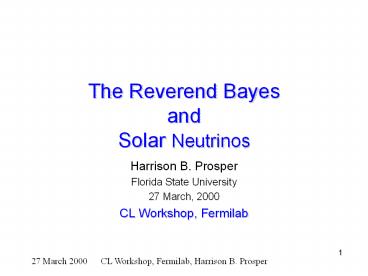The Reverend Bayes and Solar Neutrinos - PowerPoint PPT Presentation
Title:
The Reverend Bayes and Solar Neutrinos
Description:
After $50 M, and half a decade, we find, alas, N = a few events, or maybe ... Degree of Belief (Bayes, Laplace, Gauss, Jeffreys, etc.) Propensity (Popper, etc. ... – PowerPoint PPT presentation
Number of Views:22
Avg rating:3.0/5.0
Title: The Reverend Bayes and Solar Neutrinos
1
The Reverend Bayesand Solar Neutrinos
- Harrison B. Prosper
- Florida State University
- 27 March, 2000
- CL Workshop, Fermilab
2
Outline
- The High Energy Physicists Problem
- Bayesian Analysis An Example
- Final Comments
3
The Problem
- After 50 M, and half a decade, we find, alas, N
a few events, or maybe even zero. - But, we can still infer an upper limit on the
cross section, and thereby perhaps exclude a
theory or two. - How do we infer the upper limit?
- How do we wish to interpret the probability?
4
The Standard Model
- Model
- Likelihood
- Prior information
- What do the uncertainties mean?
- Are they statistical, systematic, theoretical or
some complicated combination of all three?
5
Statistical Inference
- Currently, statistical inference is based on
probability - To be useful probability must be interpreted.
- Relative Frequency (Venn, Fisher, Neyman, etc.)
- Degree of Belief (Bayes, Laplace, Gauss,
Jeffreys, etc.) - Propensity (Popper, etc.)
- The validity of these interpretations cannot be
decided by an appeal to Nature. - Statistical inference is based on principles that
can always be challenged by anyone who doesnt
find all of them compelling. Again, Nature cannot
help. - Statistical inference cannot be fully objective.
6
Frequentist Inference
- The Good
- No arbitrary priors Absence of prior anxiety!
- Coverage property is powerful (some say
beautiful) - There is a badness of fit test
- One can play delightful MC games on a computer
- The Bad
- No systematic method to incorporate prior
information - Grosse Fuge reasoning is difficult and
unnatural - The Ugly
- Difficult to teach
- Doesnt do what we want Prob(TheoryData)
Grosse Fuge, Beethoven, 1825
7
Bayesian Inference
- The Good
- Natural model of inferential reasoning
- General theory for handling uncertainty in all
its forms - Results depend only on data observed
- Does what we want Prob(TheoryData)
- Easy to teach and understand
- The Bad
- Can be computationally demanding
- Until recently, no goodness of fit test
- The Ugly
- Choosing prior probabilities can be, well, a
Grosse Fuge!
8
A Frequentist uses impeccable logic to
answer the wrong question, while a Bayesian
answers the right question by making assumptions
that nobody can fully believe in. P.G.
Hamer
Bayesian
Frequentist
9
Back to our Problem
posterior
prior
likelihood
Yes, but how do we encode this prior information?
10
Bayesian Analysis An ExampleSolar Neutrinos
C. Bhat, P.C. Bhat, M. Paterno, H.B. Prosper,
Phys. Rev. Lett. 81, 5056 (1998)
11
Making Sunshine
0.862 MeV(90), 0.383 MeV(10)
14.06 MeV
12
Solar Neutrino Spectrum
Flux at Earth pp 6.0 7Be 0.49 8B
5.7x10-4 (1010 cm-2 s-1)
J.N.Bahcalll
John Bahcall
13
Solar Neutrino Problem 1998
SNU
SNU
SNU
http//www.sns.ias.edu/jnb/Snviewgraphs/threesnpr
oblems.html
14
Super-K Electron Recoil Spectrum
Super-Kamiokande Collaboration, Phys. Rev. Lett.
82, 2644 (1999)
15
The Model Survival Probability
The neutrino survival probability is The
probability that a solar neutrino of a given
energy En arrives at the Earth.
We shall model the probability as follows
16
The Model Event Rates
17
The Model Electron Recoil Spectrum
T measured electron kinetic energy t true
electron kinetic energy R(Tt) Super-K resolution
function
18
Spectral Sensitivity
19
Bayesian Analysis - I
posterior
prior
likelihood
20
Bayesian Analysis - II
marginalization
21
Pr(pD) Active Neutrinos
22
Pr(pD) Sterile Neutrinos
23
Final Comments
- The criteria for choosing a particular theory of
inference are ultimately subjective - Does the theory do what we want?
- Is the theory natural and easy to understand?
- Is the theory powerful and general?
- Is the theory well-founded?
- Bayesian theory does what I want!
- Prior probabilities can be arrived at in a
principled manner. - However, not everyone will agree with your
principles! - But even with conventional choices for prior
probabilities it is possible to do real science.































